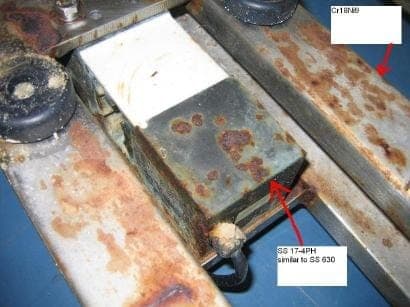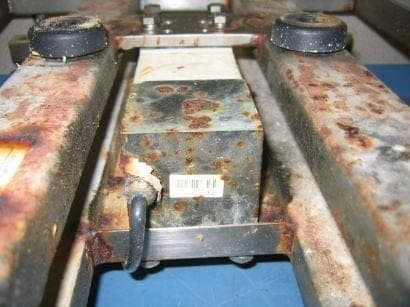
-----
Corroding stainless steel weighing platform in food processing environment
2007
I am a project engineer working for a company that produces weighing scales for industrial and food environments. We have a stainless steel product that has passed a 72 hour salt vapor test with very little staining but is now showing severe rust, and staining during only one month of use in the food industry environment.
The scale is made of a stainless steel welded tubular frame. The stainless steel has only been specified as Cr18Ni9 so I am not sure of its exact grade. I also do not know if it has been passivated or surface treated in anyway.
The stainless steel tubular frame is also covered by a 2mm thick stainless steel pan of the same specification Cr18Ni9. There is also a stainless steel column attached to base. Both the pan and column show very little stain.
There is also a load cell in the middle of the frame under the pan which is made of 17-4PH stainless steel which is said to have the same corrosion resistance as SS 630. But it too has shown a lot of rust and has discolored to green.
Here is what I know of the environment.
The scale is used in a food packaging facility where liquids such as vinegar
⇦in bulk on
eBay
or
Amazon [affil link] and tomato puree accelerating the damage?
If the pan was removed and the frame was hosed down and allowed to air dry before use would the results be a lot better?
Is there a grade of stainless steel that can eliminate this problem?
Is a surface treatment required?
If I did use a better grade of SS metal and surface treatment would I still be required dry the product completely after each cleaning?
There are other products in the facility including other scales that are cleaned the same way but do not show any rust at all.
We are of course trying to find the cheapest solution, so keep that in mind with any suggestions.
We greatly appreciate your help.


product designer - Morristown, New Jersey
Michael:
I was saddened to see your enquiry has been ignored.
As comprehensive as the details you provided are, many questions still remain. With the mix of alloys employed, and the probability of other metals used in the fabrication of the scales, there is a strong possibility that we have a case of galvanic corrosion. The bulk of the materials used in the manufacture of the scale is an austenitic stainless. Are the containers you are weighing metallic? What state are the welds in?
The severity of the corrosion happening in such a short space of time would indicate any number of metallurgical problems. My recommendation would be for you to have a metallurgist look at this.

Joel Levinsohn
- Sydney, Australia
2007
First of two simultaneous responses --
Our experience with stainless steel in your application is that you can solve and avoid most corrosion problems by using electropolishing as finish for your stainless steel parts.
When we look at your photo's I fear the corrosion is too deep to repair the problem in this specific situation, but you could try it. Anyway, you can ad this finish to the specs for future projects.
I am always surprised that electropolishing is so unknown as a solution for cleaning- and corrosion problems. In many situations this treatment reveals extraordinary results and the treatment cost is very moderate.
Kind regards,
Marc.
- Brugge, Belgium, Europe
2007
Second of two simultaneous responses -- 2007
Hi,
A food processing plant might give away the answer. Stop looking for the most unpredictable answer. Have you got other equipment off the same supplier? does it have same corrosion? I'm sure the scales come into contact with more aggressive chemicals than what you describe. Nitric acid? (((Sodium nitrate))). potassium nitrate? what cleaning agents are you using? the H2O might be causing the oxide corrosion but it is not penetrating the stainless protection layer. most of your tanks would be made from ss. does your process go through a homogeniser? In conclusion in my opinion one of the preservatives which are in full concentration are penetrating the ss at an other stage of the process like I would bet that you use the same scales for a different process now and then. lets face it scale are tempermental and become unusable now and again thus causing switching. in the end of the day. your end product is for human consumption. the chemical I've highlighted could be your answer. so have a spare for each section and stop swoping.
best of luck
- Galway
2007
Hello,
You have the response:
The liquids mixture: acetic acid
⇦ on
eBay
or
Amazon [affil link] + Tomatoe juice is corroding your material. This reaction could be accelerate by a galvanic effect. The difference of the scales oxidation is based on the metal surfaces due to a severe attack that denaturalized already the surface.
- Minneapolis, MN, USA
I agree that the corrosion has gone too far to fix it in any easy way. Send it out to a job shop to be cleaned up and passivated or electropolished, if possible.
As to whether there are better grades of stainless, the answer is definitely! Like always, it is a matter of cost of the steel, but if you want to prevent this kind of problem use 316L or 2205 possibly.
As to the cause of the problem I am sure that it is a mix of things here. You say you have other scales there that are NOT rusted, correct? Are those scales used with the same products or different? Were they made by the same manufacturer? Tomato juice is quite corrosive.
There is some bad steel around these days, so this is also a possible cause. Never assume that if the certificate of assay meets the specification that you have good steel.

Lee Kremer
Stellar Solutions, Inc.
McHenry, Illinois

January 2, 2008
My company experienced discoloration and staining of stainless steel surfaces on certain racks. Our investigation yielded that the pooling of iron, from our clean water source that was regularly used to wash the flat, non-polished surfaces, caused the discoloration and staining. We never had any corrosion or pitting. All of this staining/discoloration was removed by polishing off the staining/discoloration with pneumatic polishing equipment.
John G. Traxler- Saint Paul, Minnesota
August 24, 2008
Q, A, or Comment on THIS thread -or- Start a NEW Thread